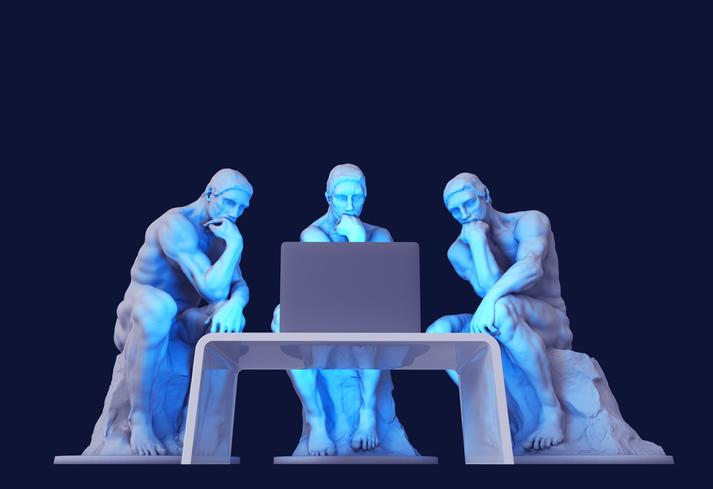It’s not news to anyone that generative AI such as ChatGPT, Google Bard and Bing all present a danger to assessment in higher education. Academic integrity is at stake when whole assessment pieces can be produced without demonstrating thinking or learning.
Responses to this development have been mixed. Blanket bans that restrict access to the sites might be tempting, but industrious students can circumvent such rules with tools like QuillBot or VPNs. Build a 10-foot wall and students will bring an 11-foot ladder.
- Collection: AI transformers like ChatGPT are here, so what next?
- Spotlight guide: Bringing GenAI into the university classroom
- A simple hack to ChatGPT-proof assignments using Google Drive
It is possible to redesign assessment to require the use of AI, where students may end up showing their conversations with ChatGPT in the same way as they show working in maths. We may be some time off being able to actualise this kind of holistic approach, though, in terms of pedagogical training and equity of access.
Another solution is to embed critical thinking into assessment (for example, moving from “What was Australia’s role in World War I?” to “Evaluate the effect of World War I on Australian cultural identity”). The second version of this task requires a more sophisticated set of cognitive skills from students. ChatGPT has limitations, after all. It does not think – it’s a language model algorithmically creating sentences. It has no self-awareness or cognitions.
However, this solution is also imperfect. It has value and practicality as assessment can be tweaked, but designing for critical thinking is messier than it appears to be. Transitioning to assessment approaches that target critical thinking may, therefore, not be the silver bullet that many hope it will be.
What is generative AI good at and not so good at?
Generative AI has truly incredible capabilities. It’s good at analysing text, synthesising information from a wide (if sometimes unreliable) set of information. It pulls from many perspectives and will articulate its responses with clarity and apparent confidence.
However, if you ask ChatGPT to evaluate the credibility of an article, it’ll give you an insipid response that does not ultimately offer a clear judgement. If you prompt it instead to provide a clear, unambiguous opinion, it may refuse to cooperate at all. Worse, it may go the other way and take a firm stance or agree with incorrect information. Despite it being easy to anthropomorphise ChatGPT and interfaces like it, they are not alive and have no experiences of their own, meaning they can’t perform tasks such as reflection or emotional reasoning either consistently or accurately.
An interesting aspect of generative AI is its commitment to objectivity (though we know that it does come embedded with biases and perspective). OpenAI is aware that ChatGPT is biased, but aims for the systems to be as be fair, unbiased and unprejudiced as much as it can. This is where assessment can be redesigned to be more AI-resilient.
Specifying the cognitive skills that are needed for a task (such as analysing, evaluating or interpreting) will not only clarify but may also create odd results in an AI’s response. It may be able to analyse a text to explain what the key ideas are, but be incapable of saying why those ideas are important. In other words, it may be quite objective in deconstructing a text but have no idea as to the relative significance of it.
That said, it isn’t necessarily proficient at being objective, either. Generative AI will attempt to follow formal rules of logic and avoid fallacy whenever possible. However, it often will fail to recognise valid arguments or conflate validity with soundness. It would be more accurate to say that generative AI merely simulates and does not take an objective disposition.
It is this quality of objectivity itself that is undesirable for many cognitive skills. Generative AI may be able to simulate a broad range of perspectives, but it has no insight into which perspectives are significant. Subjective judgements and values need to be fed to the machine via prompts in order to increase the relevance of its responses.
The challenge then is figuring out questions that flummox the AI without creating wildly difficult problems for students.
Values of enquiry, dispositions and metacognition
Evaluation and analysis are cognitive skills that sit under the umbrella of critical thinking; educators already develop and assess these. However, critical thinking encompasses other domains such as values of enquiry (for example, accuracy, clarity and coherence), dispositions (curiosity, rigour and open-mindedness) and metacognition (thinking about thinking). Critical thinking is about the critical thinker; it is about a person engaging with the quality of ideas in a certain way with a certain mentality.
Critical thinkers can perform skills such as analysis, to be sure, but they also go about these tasks thoughtfully and with intellectual humility. They come to subjective judgements. AI cannot think critically because it does not know what to value, has a bias towards fairness, and most certainly cannot reflect on its own thoughts.
Critical thinking requires subjectivity. We recognise when a task requires personal opinions and perspectives and, most importantly, to value them. Both a question and its answer come from a perspective from within a course, within a discipline, within a culture.
The challenge of including critical thinking in assessment is that this subjectivity is required, not just the cognitive skill. Evaluation, reflection, inference and ethical consideration are all examples of cognitive skills that depend on subjective judgement to determine important and relevant information. The more perspective and ambiguity factor into a question, the more critical thinking and discerning judgement are going to be required to answer it.
While assessing for critical thinking has been touted as the solution to the challenges to assessment posed by the emergence of generative AI, the situation is far from straightforward. Some of these cognitive skills can be simulated by generative AI, others less so. Redesigned assessment tasks will need to focus on the most subjective and human aspects of what it means to be a critical thinker.
Luke Zaphir is a learning designer with the digital assessment team at the Institute for Teaching and Learning Innovation; Jason M. Lodge is an associate professor and deputy associate dean (academic) of the Faculty of Humanities and Social Sciences, both at the University of Queensland.
If you would like advice and insight from academics and university staff delivered direct to your inbox each week, sign up for the Campus newsletter.




comment